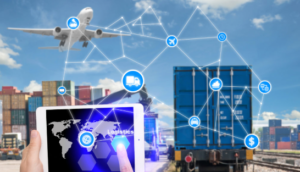Technology applied in supply chain management and logistics

Driven mostly by technical developments, the logistics and supply chain management (SCM) industry has seen a significant change in the modern society. This paper investigates how several technologies are changing supply chains and logistics, so improving efficiency, openness, and consumer happiness.
Logistics and Supply Chain Management’s Evolution
Historical Context:
From their beginning, supply chain management and logistics have changed dramatically. Supply chains were linear in the past and were defined by ineffective procedures and poor visibility. Minimal coordination among goods transferred from one place to another led to delays and higher expenses.
Technology’s Part in Things
Particularly in the late 20th and early 21st centuries, technology started to fundamentally affect the logistics sector. Thanks to developments allowing real-time communication and data analysis, supply chains are more linked and simplified today.
Leading Technologies Changing Logistics
1. Internet of Things (IoT)
The Internet of Things (IoT) is a network of linked data-exchanging, communicative objects. IoT devices can track and monitor shipments in real-time in logistics, therefore offering priceless information on the location and state of items.
IoT benefits logistically in real-time tracking of shipments, hence lowering uncertainty.
IoT sensors enable predictive maintenance—that is, the ability to forecast equipment faults before they occur, therefore reducing downtime.
RFID tags and smart shelves help to maximize inventory levels, hence lowering waste.
2. Artificial Intelligence: AI
Within supply chain management and logistics, artificial intelligence is transforming decision-making procedures. Large dataset analysis helps artificial intelligence systems to forecast demand trends, maximize paths, and improve supply chain visibility.
Applications of artificial intelligence in supply chain demand forecasting allow past data analysis to project future demand, hence enhancing inventory control.
AI systems can find the most effective delivery paths, therefore lowering delivery times and fuel consumption.
AI-powered chatbots in automated customer service can answer questions, freeing human workers for more difficult chores.
3. Blockchain Methodologies
Blockchain technology presents a clear and safe approach for tracking purchases all through the supply chain. Blockchain’s distributed ledger helps to improve logistics’ traceability and responsibility.
Benefits of Blockchain for SCM
Every transaction is noted and cannot be changed, so guaranteeing product authenticity.
Blockchain lower the possibility of fraud and illegal access to private data.
Smart contracts help to automatically create agreements and payments, therefore lowering administrative expenses.
4. Robots and Automation
Warehouse operations are being revolutionized by robotics and automation, which also increase their efficiency and help to lessen the need on human labor. Faster than human employees, automated systems can pick, pack, and classify goods.
How Robotics Affects Logistics
Because they can run around-the-clock, robots greatly boost throughput.
Automation can lower human mistake and help to save labor costs.
Robots can manage dangerous materials, therefore lowering the possibility of workplace injuries.
5. Analytics for Big Data
Big data analytics is pattern and insight discovery from vast amounts of data. This technology can enable companies in logistics make wise decisions grounded on data-driven insights.

How Big Data Improves Shipping
Predictive analytics let companies forecast consumer behavior and changes in the market, so enabling preemptive changes.
Companies can monitor important performance indicators (KPIs) to evaluate effectiveness and point up areas needing work.
Data analysis helps to expose supply chain inefficiencies and bottlenecks, hence guiding focused changes.
Obstacles in Using Technology in Logistics:
1. Exensive Initial Expenses
For small to medium-sized businesses specifically, investing in new technologies can be costly. Companies must assess the future benefits against the initial cost expense.
2. Opposition to Modifications
Workers who worry about job loss or retraining may object to implementing new technologies. Overcoming this obstacle mostly depends on change management techniques.
3. Concerns about Data Security
Data security is a top issue given growing dependence on digital systems. Businesses have to put strong cybersecurity policies into use to guard private data.
The Logistic Future of Technology
Emerging Patterns
Several trends in logistics and SCM are starting to show as technology develops. These patterns will help to define the direction of the sector.
1. Ecological Methodologies
For many firms, sustainability is starting to take front stage. Technologies lowering carbon footprints—such as electric cars and energy-efficient warehouses—are becoming popular.
2. Independent Cars
The creation of driverless cars is poised to transform transportation. Self-driving trucks and drones both seem to speed delivery and save labor expenses.
3. AI and Advanced Analytics
As analytics tools and artificial intelligence develop, they will become ever more important to logistics. Enhanced supply chain management adaptability made possible by real-time data processing and sophisticated algorithms will enable.
Finally
All things considered, supply chain management and logistics are changing thanks in great part to technology. These developments from IoT and artificial intelligence to blockchain and automation are improving customer satisfaction, openness, and efficiency. Driven by ongoing technological development, the future of logistics promises to be even more dynamic and linked, despite still existing problems.
Adopting these improvements will help companies position themselves for success in a setting growingly competitive. A more efficient and sustainable future is made possible by the technology revolution about to sweep the logistics sector, redefining how goods are transported and handled.